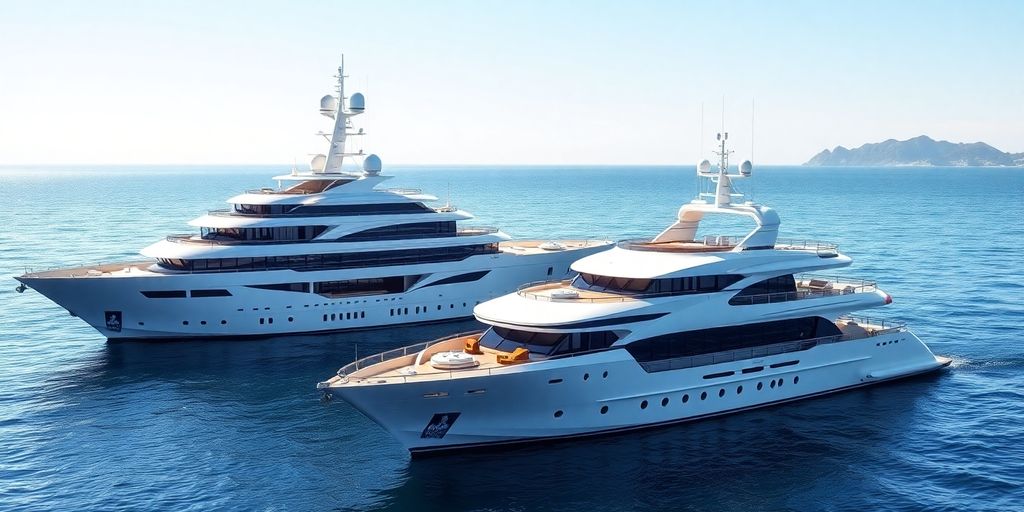Ever wonder about those massive, fancy boats you see pictures of? You know, the ones that look like floating mansions? It turns out, there’s a whole world of different names for them, and it can get a little confusing. We’re talking superyacht vs mega yacht – what’s the deal? This article will break down the differences, so you’ll know exactly what makes one bigger or more luxurious than the other. We’ll look at everything from their size to what kind of cool stuff they have on board, and even who owns them.
Key Takeaways
- Superyachts usually start around 98 feet long, while megayachts are much bigger, often over 200 feet.
- The bigger the yacht, the more fancy stuff it tends to have, like helipads, pools, and movie theaters.
- Larger yachts need a bigger crew to keep everything running smoothly and to take care of guests.
- Superyachts and megayachts are usually owned by really rich people, and they might rent them out for special parties or trips.
- There are different rules and classifications for these big boats, especially when it comes to safety and how they’re used.
Defining Superyacht and Megayacht

Superyacht Size Thresholds
Okay, so let’s get this straight. What exactly makes a yacht a superyacht? It’s all about size, but there’s no single, universally agreed-upon number. Generally, we’re talking about yachts that are at least 30 meters (around 98 feet) in length. But honestly, most people consider it to be more like 40 meters (130 feet) and up. These aren’t your average weekend cruisers; they’re serious luxury vessels. Think of them as floating mansions, equipped with all the bells and whistles you could imagine. You’ll find superyachts with Jacuzzis, gyms, and even cinemas onboard.
Megayacht Dimensions and Scale
Now, things get even bigger. When a superyacht just isn’t enough, you move into megayacht territory. There’s no official definition, but generally, a megayacht is a yacht that’s over 75 meters (about 246 feet) long. These are seriously impressive vessels, and the step up in size means a whole new level of luxury and capability. We’re talking about multiple decks, helicopter pads, and even small submarines. The sheer scale of these yachts is mind-boggling. They require a large crew to operate and maintain, and the cost of ownership is astronomical.
Gigayacht: The Pinnacle of Size
And then there’s the gigayacht. These are the absolute giants of the yachting world. Think of them as the unicorns of the sea. While not an official classification, gigayachts are generally considered to be over 100 meters (328 feet) in length. These vessels are so large that they often push the boundaries of what’s technically possible. They’re incredibly rare, and only a handful exist in the world. They represent the ultimate expression of wealth and luxury, and they’re truly in a league of their own. The yacht classifications are important to understand.
It’s important to remember that these are just general guidelines. There’s no official governing body that dictates exactly what constitutes a superyacht, megayacht, or gigayacht. It often comes down to a combination of size, features, and overall impression. But one thing is for sure: these are all incredibly luxurious and impressive vessels.
Luxury Amenities and Features
Superyachts and megayachts aren’t just about size; they’re about the experience. Think of them as floating luxury resorts, packed with features you wouldn’t believe. It’s all about creating an unforgettable time on the water.
Onboard Facilities Comparison
When you step aboard a superyacht or megayacht, you’re entering a world of unparalleled luxury. Forget cramped quarters and basic amenities. We’re talking multiple decks, sprawling living areas, and facilities that rival those of a five-star hotel. The difference in onboard facilities between a standard yacht and a superyacht is staggering.
Here’s a quick look at some common features:
- Swimming pools (sometimes more than one!)
- Hot tubs and jacuzzis
- Private cinemas
- Gyms and spas
- Helipads (on larger vessels)
It’s not just about having these things; it’s about the quality and the attention to detail. Everything is designed to provide the ultimate in comfort and convenience.
Customization and Bespoke Design
One of the biggest draws of superyachts and megayachts is the level of customization available. Owners can work with designers and shipyards to create a vessel that perfectly reflects their tastes and needs. Want a specific type of wood for the interior? No problem. Need a dedicated art gallery? Consider it done. This level of bespoke design is what sets these yachts apart.
Recreational Features and Entertainment
Beyond the standard luxury amenities, superyachts and megayachts often boast an array of recreational features designed to keep guests entertained. These can include:
- Water sports equipment (jet skis, paddleboards, diving gear)
- Onboard nightclubs or dance floors
- Gaming rooms
- Tenders and smaller boats for exploring secluded coves
Some yachts even have unique features like: Submarines, climbing walls, and golf simulators. The possibilities are endless. It’s all about creating a playground on the water. These yachts are often showcased at prestigious yacht shows around the world.
Crew Requirements and Operations
Professional Crewing Standards
Operating a superyacht or megayacht isn’t like taking out a small boat. It demands a highly skilled and professional crew. The level of training and certification required goes up with the size and complexity of the vessel. You’re talking about captains with years of experience, engineers who can manage complex systems, chefs who can create gourmet meals, and hospitality staff who provide top-notch service. These aren’t just jobs; they’re careers requiring specialized knowledge.
Crew-to-Guest Ratios
The crew-to-guest ratio is a big deal on these yachts. It’s all about providing an exclusive and personalized experience. The bigger the yacht, the more crew members are needed to maintain that level of service. A typical ratio might be 1:1 or even higher, meaning one crew member for every guest. This ensures that every need is met, from preparing custom cocktails to arranging excursions. It’s a floating luxury hotel, and the staff needs to match that standard. Larger yachts often necessitate a licensed crew.
Operational Complexity and Maintenance
These yachts are complex machines. They have advanced navigation systems, intricate mechanical components, and sophisticated entertainment setups. Keeping everything running smoothly requires a dedicated team of engineers and technicians. Maintenance is constant, from hull cleaning to engine overhauls. The operational complexity also extends to logistics, like provisioning, fuel management, and waste disposal. It’s a 24/7 operation, and the crew needs to be prepared for anything.
Think of it like this: owning a superyacht or megayacht is like running a small business. There are budgets to manage, schedules to keep, and a team of people to oversee. It’s not just about cruising around in style; it’s about managing a complex operation with a lot of moving parts.
Ownership and Usage Patterns

Ultra-High-Net-Worth Ownership
Superyachts and megayachts are, without a doubt, toys for the ultra-rich. We’re talking about individuals with net worths that allow them to consider these floating palaces as viable purchases. Owning one of these vessels is a statement, a symbol of success and a lifestyle choice. It’s not just about the money; it’s about the freedom and exclusivity that comes with it. You can find a list of yacht owners online, if you’re curious.
Chartering for Exclusive Events
While some owners keep their yachts strictly private, many choose to charter them out. This can offset some of the considerable running costs and also allows others to experience the luxury lifestyle, even if just for a week or two. Chartering is popular for:
- Corporate events: Impress clients or reward employees with an unforgettable experience.
- Family gatherings: Celebrate milestones in style and privacy.
- Special occasions: Host weddings, anniversaries, or birthdays on the water.
Chartering provides a unique opportunity to experience the superyacht lifestyle without the full commitment of ownership. It’s a way to test the waters, so to speak, and see if the yachting life is truly for you.
Private Leisure Versus Commercial Use
The line between private leisure and commercial use can sometimes blur. A yacht primarily used by its owner for personal trips is considered private. However, if the yacht is frequently chartered out, it may be classified as a commercial vessel, which comes with different regulations and requirements. The usage dictates the vessel classification and impacts everything from insurance to crew qualifications. Here’s a simple breakdown:
| Use Case | Primary Purpose | Regulatory Implications |
|---|---|---|
| Private Leisure | Owner’s personal use | Fewer regulations, focus on safety and pleasure craft rules |
| Commercial Charter | Generating rental income | Stricter regulations, commercial certifications required |
Regulatory Frameworks and Classifications
Maritime Rules and Safety Standards
Okay, so when you’re dealing with something as big and expensive as a superyacht or megayacht, you can bet there are a ton of rules to follow. It’s not like driving a car where you just need a license. We’re talking about international maritime rules and safety standards that cover everything from how the yacht is built to how it’s operated. These rules are in place to protect the people on board, the environment, and other vessels out at sea. Think of it like this: a small mistake on a big yacht can have HUGE consequences, so everyone needs to be on the same page with safety.
- Safety equipment requirements.
- Pollution prevention protocols.
- Navigation and communication systems standards.
Distinctions in Vessel Classification
It’s not just about size; it’s about how the vessel is used and what it’s designed for. A yacht used for private leisure has different classifications than one used for commercial charters. These classifications affect everything from insurance rates to the level of crew training required. Getting the classification right is super important to avoid legal headaches down the road.
| Classification | Recreational Vessel | Pleasure Craft (MCA-classed) | Commercial Vessel (IMO-regulated) |
|---|---|---|---|
| Use | Private use | Chartering, private use | Cargo, passenger transport |
Legal Implications for Large Yachts
Owning a superyacht or megayacht isn’t just about the fun and games; there are serious legal implications to consider. We’re talking about things like registration, taxation, and compliance with international laws. If you mess up any of these, you could face hefty fines, or even have your yacht impounded. It’s a good idea to have a team of lawyers and maritime experts on your side to help you navigate these waters.
The legal landscape for large yachts is complex and constantly evolving. Staying informed about the latest regulations and seeking expert advice is crucial for responsible ownership and operation.
- Flag state registration requirements.
- VAT and import duties.
- Liability and insurance considerations.
The Evolution of Yachting Size
Historical Context of Yacht Growth
The story of yachting is really a story of increasing size and luxury. Early yachts were simple vessels, often used for transport or fishing. Over time, as wealth grew, so did the desire for bigger, more elaborate boats. The transition from basic boats to luxurious yachts reflects changing social priorities and technological advancements. Think about it: the earliest yachts were for practical purposes, but now they’re floating palaces. It’s a wild change!
Market Demand for Larger Vessels
What’s driving the demand for bigger yachts? Several factors are at play:
- Increased wealth: More ultra-high-net-worth individuals are looking for ways to spend their money, and a superyacht is a pretty good option.
- Desire for exclusivity: Owning a large yacht offers a level of privacy and exclusivity that’s hard to find elsewhere. It’s like having your own private island that can move around.
- Technological advancements: New technologies make it possible to build larger, more complex yachts than ever before. We’re talking about things like advanced propulsion systems, better materials, and sophisticated navigation equipment.
It’s interesting to see how the market responds to these trends. Shipyards are constantly pushing the boundaries of what’s possible, and owners are always looking for the next big thing. It’s a cycle of innovation and demand that keeps driving the industry forward.
Industry Trends in Yacht Design
Yacht design is constantly evolving, with new trends emerging all the time. Some of the key trends include:
- Emphasis on sustainability: Owners are increasingly interested in eco-friendly yachts that minimize their environmental impact. This includes things like hybrid propulsion systems, solar panels, and waste management systems.
- Integration of technology: Yachts are becoming more and more connected, with advanced entertainment systems, smart home technology, and remote monitoring capabilities. It’s like having a floating tech hub.
- Focus on customization: Owners want yachts that reflect their personal style and preferences. This means working closely with designers and builders to create a truly unique vessel. You can find yachts for sale that are pre-designed, but many owners prefer to customize their own.
Impact on the Yachting Industry
Economic Influence of Large Yachts
The superyacht sector isn’t just about luxury; it’s a significant economic engine. The construction, maintenance, and operation of these vessels generate substantial revenue for shipyards, suppliers, and service providers worldwide. Think about it: each yacht requires specialized equipment, skilled labor, and ongoing upkeep, all contributing to a multi-billion dollar industry. The Monaco Yacht Show, for example, is a huge event, showcasing the latest and greatest, and it’s a bucket list item for anyone serious about shopping for a yacht.
Shipyard Specialization and Innovation
The demand for ever-larger and more luxurious yachts has pushed shipyards to specialize and innovate. We’re seeing yards focus on specific types of yachts, like explorer vessels or high-performance sailing yachts. This specialization drives innovation in design, engineering, and construction techniques. It’s not just about building bigger; it’s about building better, more efficient, and more technologically advanced vessels. Here are some areas where innovation is key:
- Hull design for improved fuel efficiency
- Integration of hybrid and electric propulsion systems
- Use of lightweight materials like carbon fiber
- Advanced navigation and control systems
Global Yacht Showcases and Events
Yacht shows and events play a vital role in the industry. They serve as platforms for showcasing new designs, technologies, and services. These events bring together builders, designers, brokers, and potential buyers, creating opportunities for networking and deal-making. Plus, they generate significant tourism revenue for the host cities. It’s all about Big Yacht Energy!
The yachting industry is constantly evolving, driven by the desires of ultra-high-net-worth individuals and technological advancements. This creates a dynamic environment where shipyards and designers are constantly pushing the boundaries of what’s possible. The environmental impact is a growing concern, leading to increased focus on sustainable yachting solutions.
Wrapping It Up: Size Isn't Everything, But It Matters Here
So, there you have it. When we talk about superyachts and mega yachts, it’s not just about throwing around fancy words. There are real differences in size, what’s inside, and even how they’re used. Knowing these things helps everyone, from folks looking to buy one of these amazing vessels to those who work on them. It just makes things clearer for everyone involved in the world of big, beautiful boats.
Frequently Asked Questions
What is the main difference between a yacht and a boat?
While all yachts are technically boats, not all boats are yachts. Yachts are typically larger (40+ feet), designed for luxury or long-distance cruising, and often come with a crew. Boats can range from small fishing vessels to speedboats used for fun or work.
Is a yacht considered a ship?
No, a yacht is not called a ship unless it meets certain size and weight rules (usually over 500 gross tons) and is used for business, like big charter trips. Most yachts are still thought of as private fun boats.
At what size does a boat become a ship?
A boat usually becomes a ship when it’s bigger than 500 gross tons or is used for business or industrial work across oceans. Ships follow different rules (like SOLAS) than boats or yachts.
What's the difference between a superyacht, megayacht, and gigayacht?
A superyacht is generally a yacht over 98 feet long, known for its extreme luxury, custom features, and a large crew. A megayacht is even bigger, typically over 200 feet, while a gigayacht is the largest, often exceeding 300 feet, like a floating mansion.
Why do these size distinctions matter?
The terms are important for legal reasons, like safety rules, taxes, and how many people can be on board. They also help shipbuilders, buyers, and insurance companies know exactly what kind of vessel they are dealing with.
Why do many large yachts only allow 12 guests, even if they're huge?
Even the biggest superyachts often have rules that limit them to carrying only 12 guests overnight. This rule comes from old maritime laws meant for passenger ships, but it applies to private yachts to keep them from being classified as commercial vessels, which have much stricter safety requirements.



